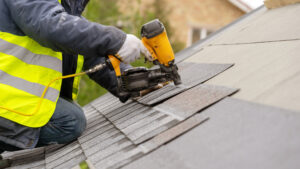Working with Riverside County, CA, specialists for roof repairs gives you peace of mind. Apart from fixing your structure with high-quality tools, they can also install a new roof made of various materials. One of your best options is asphalt.
But have you ever wondered: what are asphalt shingles made of and how are they constructed? We’ll be answering that question in the following article. Read on!
What are asphalt shingles made from?
There are many reasons you should consider mounting asphalt shingles. They go a long way when it comes to minimizing storm damage and help prolong the lifespan of your roof. They owe these properties to the materials used in their production.
Contrary to popular belief, asphalt shingles aren’t entirely made of asphalt. Instead, they’re made of felt paper or fiberglass base, which is coated with a waterproof layer of asphalt. There are also ceramic granules.
Other products were used for the base, but manufacturers switched to fiberglass in the 1980s. It’s less expensive and lighter than some other products, yet it offers considerable fire protection and strength.
How are asphalt shingles constructed?
Here’s what asphalt production normally involves:
Processing asphalt
Asphalt is the fundamental water-resistant substance in any asphalt shingle. This oil-refining product is processed to achieve excellent durability, which ensures optimal performance. The material is also oxidized by hot air to increase its viscosity. The air blowing must be very precise.
After the oxidization, technicians mix a mineral powder with asphalt to make the shingles weather- and fire-resistant. This coating is pressed at the top and bottom of a fiberglass mat.
Adding granules
One of the most important parts of asphalt shingles is the granule surface. It consists of hard rock that has been grinded down into granules. These granules are then incorporated into sections of shingle that aren’t exposed.
These granules are later colored with ceramic firing, giving them permanent colors on exposed shingle parts. Some manufacturers also add algae-resistant granules to reduce the risk of discoloration caused by various algae. Also, they may use reflective granules to help the material reflect a greater portion of sunlight.
Sealing
The producer applies a thermally-activated sealant to shingles, allowing them to link the units on your roof. Plus, they add laminate on multi-layer models to bond shingle layers. The adhesives are carefully designed, so they activate at appropriate temperatures. This way, they’re less likely to break during the mounting stage, or if they encounter high winds and other adverse circumstances.
Finishing touches using release film
You’re probably wondering what prevents sealants from activating and making shingles stick to each other when stored in a warehouse or at high temperatures. The key lies in a material called release film.
This substance is on duty only while shingles are packaged and sealed. Once professionals install them, the release film remains on the surface but doesn’t have any purpose.
Having problems with your roof? Get in touch with top-tier Riverside County, CA, experts in roof repairs!

DIY maintenance and repairs are risky, as they often lead to injuries. Besides, why waste hours on your roof when you can discover the history of the citrus industry at California Citrus State Park? Leave roof-related projects to 619 Roofing!
Our team has vast experience resolving various problems, no matter their severity. We can use state-of-the-art equipment to inspect the property and diagnose the issue within minutes. Once the work starts, you’ll witness our industry-leading methods first-hand. Book today for fantastic results!